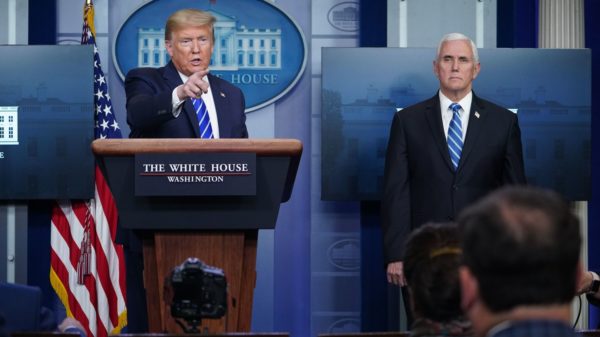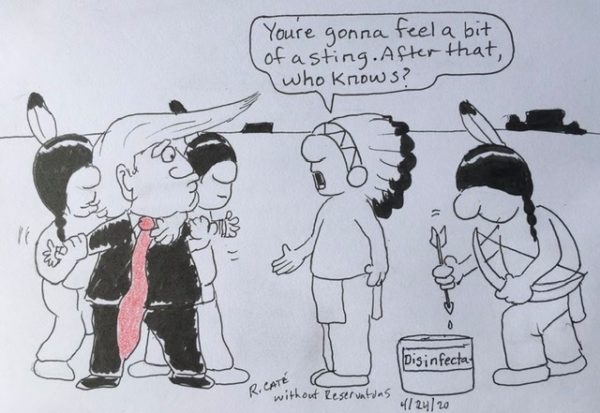
- Details
- By Levi Rickert
WASHINGTON — What appeared to be a stream of consciousness thought verbalized by the President at Thursday’s White House coronavirus task force press briefing drew immediate criticism from physicians and other medical experts.
At Thursday’s daily press brief, President Trump suggested injection of disinfectants may be a way to cure someone who test positive for COVID-19. The president made the remark after the head of the Department of Homeland Security's science and technology division, gave a presentation on research his team has conducted that shows that the deadly virus doesn't live as long in warmer and more humid temperatures.
"The virus dies quickest in sunlight," William N. Bryan, the acting undersecretary for the science office in the Department of Homeland Security said.
The remark seemed to leave Trump to wonder whether you could bring the light "inside the body.”
"So, supposing we hit the body with a tremendous — whether it's ultraviolet or just a very powerful light — and I think you said that hasn't been checked because of the testing," Trump wondered out loud. "And then I said, supposing you brought the light inside the body, which you can do either through the skin or some other way, and I think you said you're going to test that, too."
The president added: "I see the disinfectant that knocks it out in a minute, one minute. And is there a way we can do something like that by injection inside or almost a cleaning? As you see, it gets in the lungs, it does a tremendous number on the lungs, so it would be interesting to check that."
“There’s no circumstance under which you should take a disinfectant or inject a disinfectant for the treatment of anything and certainly not for the treatment of coronavirus,” a former FDA commissioner said on CNBC’s “Squawk Box.” “There’s absolutely no circumstance under which that’s appropriate and it can cause death and very adverse outcomes.”
While the president did not name Lysol, a leading manufacturer of disinfectant products, a Lysol spokesperson said “under no circumstance should our disinfectant products be administered into the human body (through injection, ingestion or any other route).”
"As with all products, our disinfectant and hygiene products should only be used as intended and in line with usage guidelines. Please read the label and safety information," the statement continued, adding that the company believes it has a "responsibility in providing consumers with access to accurate, up-to-date information as advised by leading public health experts."
 Used with permission
Used with permission
The Centers of Disease Control and Prevention (CDC) says there already has been an increase of calls into poison centers this year versus last year related to cleaners and disinfectants. Poison centers report 45,500 exposure to cleaners and disinfectants calls—a 20.4 percent increase for the first quarter of this year.
The CDC advises that consumers read and follow directions on the label on all cleaners and disinfectants, avoid mixing chemical products, wear eye and skin protection, ensure adequate ventilation and store chemicals out of the reach of children.
More Stories Like This
Native News Weekly (August 25, 2024): D.C. BriefsUS Presidents in Their Own Words Concerning American Indians
NDAA passes House; Lumbee Fairness Act Advances
NFL, Vikings to Host Native All-American Game, Youth Flag Clinic
Senate Committee on Indian Affairs Passes 12 Bills to Strengthen Tribal Communities
Help us defend tribal sovereignty.
At Native News Online, our mission is rooted in telling the stories that strengthen sovereignty and uplift Indigenous voices — not just at year’s end, but every single day.
Because of your generosity last year, we were able to keep our reporters on the ground in tribal communities, at national gatherings and in the halls of Congress — covering the issues that matter most to Indian Country: sovereignty, culture, education, health and economic opportunity.
That support sustained us through a tough year in 2025. Now, as we look to the year ahead, we need your help right now to ensure warrior journalism remains strong — reporting that defends tribal sovereignty, amplifies Native truth, and holds power accountable.
 The stakes couldn't be higher. Your support keeps Native voices heard, Native stories told and Native sovereignty defended.
The stakes couldn't be higher. Your support keeps Native voices heard, Native stories told and Native sovereignty defended.
Stand with Warrior Journalism today.
Levi Rickert (Potawatomi), Editor & Publisher

